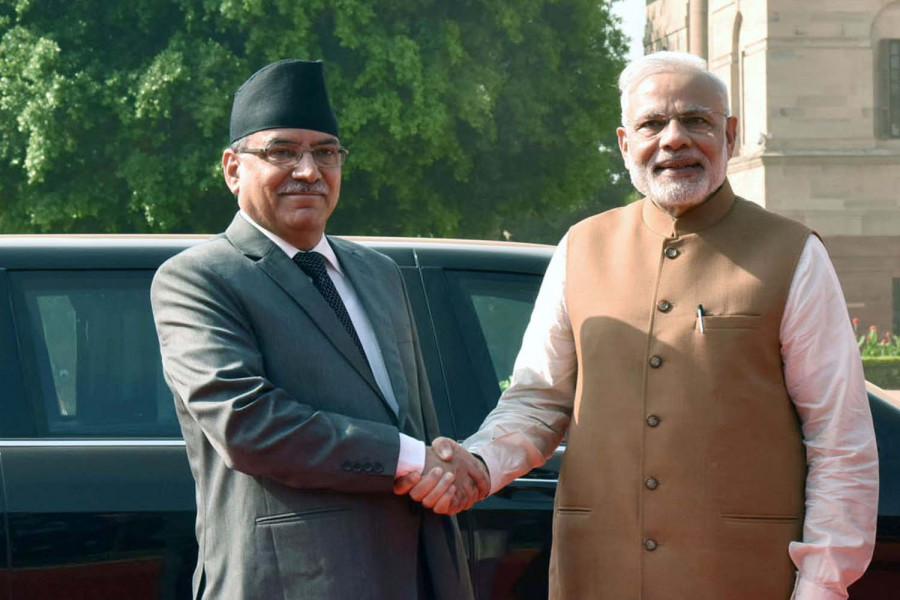Columns
Dealing with a new India
Nepali leaders cannot even list five things, let alone know how to communicate them.
Sujeev Shakya
Last week in Delhi, my cabbie sought my opinion about the prime minister of Papua New Guinea falling at Indian Prime Minister Narendra Modi’s feet. I did not have an answer. I also could not answer when he asked me if Prime Minister Pushpa Kamal Dahal would do the same when he visits New Delhi this week. The taxi driver went on a rant about how Modiji had now put India on the global map and how the world was bowing down to India.
Many of my friends who were educated in liberal institutions around the world have WhatsApped me the video of the incident that has gone viral. On Sunday, when India inaugurated its new Parliament building, it was very clear how it has redefined its democracy. A prime minister inaugurates the building with a Hindu ritual, clearly sending a message: “This is how we are and how we will be in the future; adjust with our thoughts or just perish.” Famous marketing strategy guru Rama Bijapurkar in her book uses the common phrase in an anglicised way, “We Are Like That Only”, explaining how Indians think and behave.
Optics is key
India, especially its political leaders, have always relied on optics and changed it to adapt with the times. Former prime minister Indira Gandhi projected herself as a messiah of the poor and addressed huge rallies. She once told her private secretary to get her a bowl of almonds as it was so tiring to be a goddess. She projected herself as a leader of a secular India, but relied heavily on godmen and astrologers to maintain her leadership. In the current day of social media, the Indian prime minister has learnt to play to the gallery and his public relations team has done a stellar job. Large business houses, who have always been the key funding source for political parties in India, have flourished across all regimes. A few perish on the way, but by and large, Indian businesses are very adaptive.
However, the current administration has been able to send the right signals to the global investment community through good optics, and investments have come into India in a large wave. The global order disrupted by Trump’s four years in the White House, the emergence of a powerful Xi Jinping in China, the Russian invasion of Ukraine, and the United Kingdom figuring out how to re-strategise post-Brexit has also given India an opportunity to establish a significant presence in the global space. The “brain drain” of India is also paying off as global corporations in the United States are getting Indian leaders, and now even the World Bank has a president of Indian origin.
Indians were able to use Rabindranath Tagore who won a Nobel Prize a century ago, and it is no surprise that they can now leverage a lot of soft power. Bollywood has been growing immensely in the global market, Indian cricket has become a colossal sporting industry and Indian cuisine is getting popular around the world by the day. It is a new India, and it is a country of people who know how to sell! If a celebrity in Hollywood eats Thai or Chinese takeaway for dinner, it is no big deal. But if they get Indian takeaway food, this can immediately become headline news in Indian broadsheet dailies within hours, and it will be followed by thousands of tweets devoted to that one action.
Modalities of engagement
The current Indian administration deals with governments in its own way. For the current foreign minister, the priority is not the neighbourhood but setting big relationships straight. So he does not meet the Nepali ambassador in Delhi for 14 months as their neighbour is an irritant rather than a relationship to proactively nurture. They still want to just engage reactively. So the Bhutan king will only be given importance in New Delhi if China is reaching out and trying to settle border issues. Former interlocutors do not matter. They do not want to listen to retirees, as they are in search of fresh young people who can provide the narrative that the prime minister's office would like to hear. There are new institutions that are emerging and new structures that are taking prominence. The focus is on making G20 successful in its optics and that is key. If you are part of that team, your voice is heard, otherwise not.
The structured working of the Indian government with people under regular surveillance has also made it difficult for leaders in countries like Nepal as they do not know how to handle issues formally. These Nepali leaders cannot write five things, let alone know how to communicate them.
As the Nepali prime minister prepares for a visit to India this week, it will be another event with the right optics, and any breakthroughs would be an added bonus. The pending issues are no different than those I pointed out in an op-ed a year ago. India realises that the Nepal prime minister leads a fragile coalition and does not reflect the change in the people’s mood during the November 2022 elections. They know the prime minister has been shaken by the Bhutanese refugee scam and is wary of potential scams that may emerge to haunt him. He also wants the optics of a good meeting. For emerging Nepali political leaders, it is now crucial to build a strategy to engage with India and deal with its new mood and institutions, all the while getting their own optics right.




 8.12°C Kathmandu
8.12°C Kathmandu















